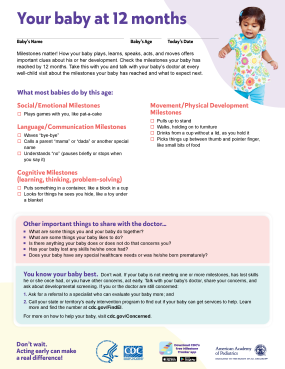Developmental Surveillance Resources
for Healthcare Providers
CDC’s milestones and parent tips have been updated and new checklist ages have been added (15 and 30 months). For more information about the updates to CDC’s developmental milestones, please review the Pediatrics journal article and these important key points.
In addition to early childhood screenings, the American Academy of Pediatrics also recommends developmental surveillance, a flexible, longitudinal, continuous, and cumulative process, at each health supervision visit to help identify children with developmental concerns. CDC’s “Learn the Signs. Act Early.” program has FREE parent-friendly milestone checklists and other resources for children 2 months to 5 years of age to support healthcare providers with this process. Watch a webinar hosted by the American Academy of Pediatrics, that focuses on understanding and incorporating Developmental Surveillance into your practice.
A Free Tool to Help Healthcare Providers: CDC’s Milestone Tracker App
CDC’s Learn the Signs. Act Early. materials include developmental milestone checklists to help parents track milestones between visits and provide guidance about what steps to take if they have concerns, like talking with their child’s healthcare provider. They have been tested for clarity, ease of understanding, have an engaging design and are written at a fifth grade reading level. Encouraging parents to complete checklists can help with developmental surveillance during health supervision visits.
The checklists are
- Available within CDC’s free Milestone Tracker app
- Free to download and print in your office
- Available to order in limited quantities
- Available in English and Spanish, with some in simplified Chinese, Vietnamese and Korean, and other languages
- Able to be customized by adding your practice’s logo
View, print, or order milestone checklistspdf icon, CDC’s Milestone Tracker app, and other free resources to help with developmental surveillance at www.cdc.gov/ActEarly/Materials.
“Learn the Signs. Act Early.”
One Doctor’s Story
Janet Siddiqui, M.D., is a pediatrician and office medical director at Johns Hopkins Community Physicians in Odenton, Maryland.
Support routine developmental surveillance in your practice with the help of CDC’s free materials.
- Print and post FREE Milestone Tracker app posters [617 KB, 1 Page, 508] in exam rooms; encourage families to download the app and complete a checklist.
- Review the app’s milestone summary during health supervision visits
- For families who prefer to use paper or speak languages other than English or Spanish, print and give the milestone checklists. Laminate the checklists and reuse as needed.
- Use a web button to link your practice website to Learn the Signs. Act Early. resources
- Use prepared social media content to promote developmental monitoring at home
- Make the case with your colleagues for using materials routinely
- Share the Healthcare Provider Primer, that explains the benefits of using LTSAE materials in pediatric settings and how to access materials and easily integrate them within practices. Primer in English [233 KB, 2 pages, 508] Primer in Spanish [242 KB, 2 Pages, 508]
- Include a PowerPoint slide [PPT – 3.11 MB] featuring the Milestone Tracker app during your next presentation and share how it can be used to help with developmental surveillance.
- AAP’s Family Friendly Referral Guide
This free, printable handout is available in English [629 KB, 2 pages, 508] and Spanish to use with families and/or caregivers to support them in taking the next steps when developmental referrals are needed. Healthcare providers can fill in the types of referrals being made and let families know how to communicate any barriers they may be experiencing in the referral process. - Birth to 5: Watch Me Thrive Screening Passport to print and use with families.
- Brazelton Touchpoints Development is a Journey Roadmap
This roadmap is designed for pediatric primary care providers to facilitate conversations if there are developmental concerns and/or after developmental screening using seven short and simple steps to actively engage parents and other caregivers in planning for their child’s developmental needs and enhance the provider-parent partnership.
Development is a Journey conversation roadmap| Roadmap Background and Guidance

Prioritizing and Facilitating Developmental Referrals
Referrals to appropriate resources should be considered if any person on the patient’s care team has concerns about the patient’s current development or identifies the patient to be at increased risk of developmental delays.
Our practice uses the ‘Learn the Signs. Act Early.’ milestone checklists and they have significantly improved our ability to conduct developmental surveillance with our patients. Our parents and providers love these resources!
– Michelle Grier-Hall MD, FAAP, Medical Director of Pediatrics, Escambia Community Clinics, Inc., Pensacola, FL
I regularly use Learn the Signs. Act Early. milestone checklists for developmental surveillance at well visits to help identify children with developmental concerns.
– Cecily Kelly, MD, FAAFP, Kelly Family Clinic, New Braunfels, TX
Developmental surveillance and screening together are more likely to identify the 1 in 6 children with a developmental disability than either one alone. Identifying these children is important so they can receive early intervention services that help improve skills, abilities, future school performance, and later success in life.

Overview of Developmental Surveillance and Screening
Developmental surveillance is a continuous process that is recommended at least at every well-child/health supervision visit through early childhood. Developmental screening, on the other hand, is done with validated screening tools with appropriate sensitivity and specificity at strategic time points in early childhood.

- This video from the AAP discusses developmental surveillance recommendations, tips, and resources.
- This study showed that children receiving developmental monitoring and screening together were more likely to receive early intervention.

This video from AAP shows how obtaining developmental information from early childhood professionals, and sharing information back, can improve early identification.
- Perform the 6 steps of developmental surveillance at each health supervision visit:
- 1.) review checklists/developmental history;
- 2.) ask about concerns;
- 3.) assess strengths and risks;
- 4.) observe the child;
- 5.) document; and
- 6.) obtain and share results with others (early childhood educators, WIC providers, home visitors, etc.).
- Encourage parents to monitor milestones between visits and share results with you:
- Print and post FREE Milestone Tracker app posters [617 KB, 1 Page, 508]in exam rooms; encourage families to download the app and complete a checklist.
- Print and give milestone checklists [4 MB, 24 Pages, 508]to families who prefer paper or speak languages other than English or Spanish; laminate and reuse them as needed.
- Conduct early childhood screenings as recommended by the AAP, using validated screening tools at recommended ages and if surveillance reveals a concern.
- Refer children with concerning results for further evaluation AND to your state’s early intervention program.

Toolkit to Implement Your Own Quality Improvement (QI) Project
This toolkit was developed by CDC and AAP to assist providers with implementing a MOC part 4 project on developmental surveillance and screening in the office.
Developmental Surveillance Mini (Spark)-Training for Pediatric Clinicians and Practices
Identify and discuss developmental surveillance best practices in your office setting. This free training, developed with support from the Centers for Disease Control and Prevention, includes a ready-to-use PowerPoint presentation, facilitator script, and case study. The training can be facilitated by providers or staff in various roles and is specifically designed to “spark” discussion and reflection. Facilitators can anticipate the training to last approximately 15-30 minutes and can be presented anywhere from staff meetings to professional development opportunities. Content in the training is grounded in the recently published AAP clinical report, “Promoting Optimal Development: Identifying Infants and Young Children with Developmental Disorders Through Developmental Surveillance and Screening.” Download a copy to present to your team today!
AAP Chapter Resource Guide
The chapter resource guide, Support for Pediatric Clinicians Conducting Developmental Surveillance, Screening, Referral, and Follow-up, is based on feedback received from chapters focused on early identification of developmental delays and disabilities. It covers how to assess community assets, discovering potential community partners, collaborating with your state’s CDC Act Early Ambassador, and finding resources to facilitate developmental surveillance and screening.
Identifying Risks, Strengths, and Protective Factors for Children and Families: A Resource for Clinicians Conducting Developmental Surveillance
A study from the Journal of Developmental & Behavioral Pediatrics indicates LTSAE may improve developmental surveillance by increasing parent’s awareness of and discussion about milestones.

A study from the Journal of Developmental & Behavioral Pediatrics suggests that LTSAE materials may help improve developmental surveillance by increasing parent-physician communication about development.
Early Intervention
Early intervention contact information by state.
Physical Developmental Delays: What to Look For
A tool developed by AAP and CDC on physical developmental delays and what to look for.
STAR Center
American Academy of Pediatrics’ Screening Technical Assistance and Resource Center for information on screening tools, practice resources, and technical assistance.
- A Healthcare provider guide to encourage healthy child development, universal developmental and behavioral screening for children, and support for the families.
AAP’s Clinical Reports Recommending Developmental Surveillance and Screening
- Promoting Optimal Development: Identifying Infants and Young Children with Developmental Disorders Through Developmental Surveillance and Screening
- Identification, Evaluation, and Management of Children with Autism Spectrum Disorder
Developmental Surveillance Mini (Spark)-Training for Pediatric Clinicians and Practices
Identify and discuss developmental surveillance best practices in your office setting. This free training, developed with support from the Centers for Disease Control and Prevention, includes a ready-to-use PowerPoint presentation, facilitator script, and case study.
The Well Visit Planner® (WVP) is a brief family-completed, online pre-visit planning tool, available in English and Spanish, carefully aligned with national Bright Futures Guidelines that covers all 15 recommended well visits between a child’s first week of life through age six. The WVP supports a comprehensive, strengths-based, and personalized approach to well-child visits and can be used to document completion of required screenings (including but not limited to developmental and maternal depression) while prioritizing trust and family-centered care.
Watch this overview video of the Cycle of Engagement Well Visit Planner Approach to learn more. Download CAHMI’s COE WVP Getting Started Toolkit and visit the CAHMI website to create your COE account and customized Well Visit Planner tool today.
Milestones in Action is a FREE library of photos and videos of children showing developmental milestones.
If a child has a developmental delay, it is important to identify it early so that the child and family can receive needed intervention services and support. Healthcare providers play a critical role in monitoring children’s growth and development and identifying concerns as early as possible. The American Academy of Pediatrics (AAP) recommends that healthcare providers do the following:
- Monitor the child’s development during regular well-child visits.
- Screen all children with validated tools at recommended ages to identify any areas of concern that may require a further examination or evaluation.
- Ensure that more comprehensive developmental evaluations are completed if risks are identified.
Developmental monitoring and screening can be done by a number of professionals in healthcare, community, and school settings in collaboration with parents and caregivers. Pediatric primary care providers are in a unique position to promote children’s healthy development because they have regular contact with children before they reach school age, and their families. The AAP encourages pediatric care providers to provide family-centered, comprehensive, and coordinated care.
Developmental Monitoring

Developmental monitoring, also called developmental surveillance, is the process of recognizing children who might be at risk for developmental delays. The AAP recommends that developmental monitoring should be a part of every well-child preventive care visit. Monitoring can include using a brief checklist of milestones, but is less formal than developmental screening. Developmental monitoring should include the following:
- Asking about parents’ concerns.
- Obtaining a developmental history.
- Observing the child.
- Identifying risk and protective factors.
- Documenting the findings.
- Share information with early childhood professionals.
If concerns are identified through developmental monitoring, they should be addressed promptly with validated screening tools to identify and refine any risk or concern that has been noticed.


Developmental Screening
Developmental screening is more in-depth than monitoring and may identify children with a developmental risk that was not identified during developmental monitoring.
The American Academy of Pediatrics (AAP) recommends developmental and behavioral screening for all children during regular well-child visits at these ages:
- 9 months
- 18 months
- 30 months
In addition, AAP recommends that all children be screened specifically for autism spectrum disorder (ASD) during regular well-child visits at:
- 18 months
- 24 months
Developmental screening with a validated test is recommended for all children at these ages even if there are no concerns. Healthcare providers may screen a child more frequently if there are additional risk factors, such as preterm birth, low birthweight, and lead exposure, among others.
Evidence-based screening tools that include reports from parents and early childhood professionals can help parents and healthcare professionals talk about the child’s development in a systematic way. A number of good screening tools designed for a variety of settings, ages, and purposes are available (e.g., Ages and Stages Questionnaire, 3rd edition, Parents’ Evaluation of Developmental Status with Developmental Milestones, and Child Development Inventory). Screening tools can be specific to a disorder (for example, autism), an area (for example, cognitive development, language, or gross motor skills), or they can be about development in general, addressing multiple areas of concern. More information is available from the AAP’s Screening Technical Assistance and Resource Center (STAR Center). A list of examples of validated screening tools is available from the American Academy of Pediatrics.
If the screening test identifies a potential developmental problem, further developmental and medical evaluation is needed. Screening tools do not provide conclusive evidence of developmental delays and do not result in diagnoses. A positive screening result should be followed by a thorough assessment done by a trained provider. A more detailed evaluation will show whether the child needs treatment and early developmental intervention services. Medical examinations can identify whether the problems are related to underlying medical conditions that need to be treated.
Children aged 0-3 years can be referred to early intervention programs and children aged 3 years and older can be referred to special education services for developmental evaluation and services. Learn more about early intervention and special education. Children with behavior problems can also benefit from parent behavior therapy and may need a referral to a mental health provider.
Teaching Parents and Caregivers to Recognize Developmental Milestones
Parents can monitor a child’s development as well. Research studies have confirmed that parents are reliable sources of information about their child’s development. Parents who are aware of developmental milestones can observe their child and inform their healthcare provider about any concerns they may have about their child’s development. Pediatric healthcare providers can provide parents with milestone checklists to track their child’s milestones at home. CDC’s “Learn the Signs. Act Early.” campaign was designed to give parents and professionals the tools they need to track healthy child development and move toward evaluation and intervention if concerns are noted.
Early care and education providers can also be a valuable source of information on how the child is developing.
- Learn the Signs. Act Early. Developmental Milestone checklists
- Birth to 5: Watch Me Thrive – Families
- Motor Delay Tool
Ensuring All Children Have a Medical Home
Quality of care is best when children receive coordinated care and services. Having a medical home means having consistent access to health care that is comprehensive, well-coordinated, and of high quality, and that provides an ongoing relationship with personal providers who treat the whole child. The AAP describes a family-centered medical home as an approach in which the pediatric care team works in partnership with a child and a child’s family to assure that all of the medical and non-medical needs of the patient are met.
In a medical home approach, developmental monitoring and screening includes the following:
- Identifying children with diagnosed developmental disorders as children with special healthcare needs and managing their care as a chronic condition.1
- Coordinating with specialists about additional evaluation that the child may need.
- Integrating feedback from early childhood providers who can monitor and screen the children in the early childhood setting.
Integrating Developmental Screening into Pediatric Primary Care
The following are resources to integrate screening services into primary care efficiently and at low cost, while ensuring thorough coordination of care:
- The CDC’s Learn the Signs. Act Early program has FREE resources and recommendations for integrating developmental surveillance into health supervision visits.
- The AAP’s Developmental Surveillance and Screening webpage has resources for pediatric clinicians, providers, and families including free courses provided by the AAP.
- Bright Futures: Guidelines for Health Supervision of Infants, Children, and Adolescents
References
- Lipkin PH, Macias MM, Council on Children with Disabilities, Section on Developmental and Behavioral Pediatrics (2020). Promoting optimal development: Identifying infants and young children with developmental disorders through developmental surveillance and screening. Pediatrics, 145(1), e20193449.



